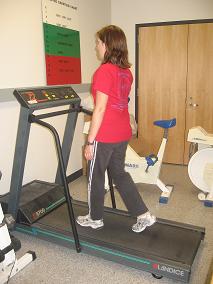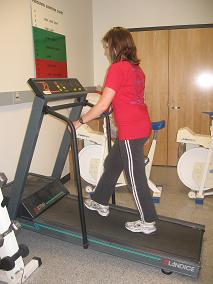Two-Stage Treadmill Test: Difference between revisions
(Created page with "{{subst: Special Test}}") |
(Added purpose, method and evidence.) |
||
| Line 3: | Line 3: | ||
== Purpose<br> == | == Purpose<br> == | ||
[[Lumbar Spinal Stenosis|Lumbar spinal stenosis]] (LSS) is a degenerative spinal clinical condition that narrows the spinal canal and/or intervertebral foramina. The two stage treadmill test is used as a clinical diagnostic tool for the differentiation of neurogenic claudication due to LSS.<ref name=":0">Cook CJ, Cook CE, Reiman MP, Joshi AB, Richardson W, Garcia AN. [https://link.springer.com/article/10.1007/s00586-019-06048-4#Sec1 Systematic review of diagnostic accuracy of patient history, clinical findings, and physical tests in the diagnosis of lumbar spinal stenosis.] European Spine Journal. 2020 Jan;29:93-112.</ref> | |||
[[File:Dianaerect.jpg|thumb|Upright posture with no incline]] | |||
[[File:Dianaslump.jpg|thumb|Flexed posture with incline]] | |||
== Technique<br> == | == Technique<br> == | ||
The test includes the patient on a level treadmill and on an inclined treadmill. Variables recorded are : | |||
# The time required until onset/increase in symptoms | |||
# The total walking time | |||
# The time required for symptoms to return to baseline | |||
Patients with lumbar spinal stenosis will demonstrate earlier onset of symptoms during level ambulation, longer total walking time during inclined ambulation and prolonged recovery time after level walking. | |||
While patients with lower extremity related pain are not going to be affected by spinal postures or will worsen during inclined walking due to increased muscular lower limbs effort. <ref name=":1">Fritz JM, Erhard RE, Delitto A, Welch WC, Nowakowski PE. Preliminary results of the use of a two-stage treadmill test as a clinical diagnostic tool in the differential diagnosis of lumbar spinal stenosis. Clinical Spine Surgery. 1997 Oct 1;10(5):410-6.</ref> | |||
== Evidence == | == Evidence == | ||
The test has low sensitivity of 50% and high specificity of 92.3%, thus findings of increased walking time on inclined versus level treadmill are highly associated with the presence of LSS.<ref name=":1" /> | |||
A 2019 systematic review found that the two-stage treadmill test, symptoms after a march test and abnormal Romberg test yielded large positive posttest probability changes (> 25%) for diagnosing LSS. <ref name=":0" /> | |||
== References == | == References == | ||
<references /> | <references /> | ||
Revision as of 13:59, 1 September 2023
Purpose
[edit | edit source]
Lumbar spinal stenosis (LSS) is a degenerative spinal clinical condition that narrows the spinal canal and/or intervertebral foramina. The two stage treadmill test is used as a clinical diagnostic tool for the differentiation of neurogenic claudication due to LSS.[1]
Technique
[edit | edit source]
The test includes the patient on a level treadmill and on an inclined treadmill. Variables recorded are :
- The time required until onset/increase in symptoms
- The total walking time
- The time required for symptoms to return to baseline
Patients with lumbar spinal stenosis will demonstrate earlier onset of symptoms during level ambulation, longer total walking time during inclined ambulation and prolonged recovery time after level walking.
While patients with lower extremity related pain are not going to be affected by spinal postures or will worsen during inclined walking due to increased muscular lower limbs effort. [2]
Evidence[edit | edit source]
The test has low sensitivity of 50% and high specificity of 92.3%, thus findings of increased walking time on inclined versus level treadmill are highly associated with the presence of LSS.[2]
A 2019 systematic review found that the two-stage treadmill test, symptoms after a march test and abnormal Romberg test yielded large positive posttest probability changes (> 25%) for diagnosing LSS. [1]
References[edit | edit source]
- ↑ 1.0 1.1 Cook CJ, Cook CE, Reiman MP, Joshi AB, Richardson W, Garcia AN. Systematic review of diagnostic accuracy of patient history, clinical findings, and physical tests in the diagnosis of lumbar spinal stenosis. European Spine Journal. 2020 Jan;29:93-112.
- ↑ 2.0 2.1 Fritz JM, Erhard RE, Delitto A, Welch WC, Nowakowski PE. Preliminary results of the use of a two-stage treadmill test as a clinical diagnostic tool in the differential diagnosis of lumbar spinal stenosis. Clinical Spine Surgery. 1997 Oct 1;10(5):410-6.








